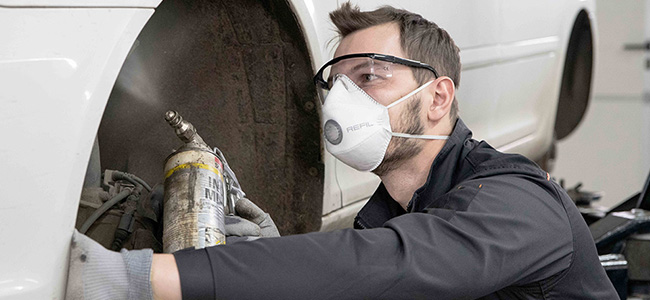
Safeguarding Against Airborne Hazards
Safeguarding Against Airborne Hazards
Air pollution poses an invisible threat in the workplace, akin to a silent assassin that can have long-term consequences. Aerosols, those minute particles floating in the air, may seem harmless, but they pose a danger to the lungs comparable to the risks associated with a circular saw. Often underestimated due to their nearly invisible nature, aerosols demand our attention. Choosing the right respiratory protection is a critical step in preventing potential health hazards, especially for those working in construction, paint shops, laboratories, workshops, and agriculture.
Effective Protection Against Aerosols in 3 Steps
1. Know the Hazard

1. Know the Hazard
Understanding the risk is the first line of defense. Even in remote locations, far from industrial chimneys, the air can contain microparticles and substances hazardous to the lungs. Natural filtering mechanisms in the body can handle a certain amount, but when the volume of these elements increases, and exposure is frequent, the body's defense mechanisms may fail. Identifying the seriousness of the hazard involves analyzing the type and concentration of particles in the air, as well as the duration of exposure in risky workplaces.
2. Eliminate Risk

2. Eliminate Risk
Before selecting suitable respiratory protection, it's crucial to minimize the risk of inhaling harmful substances. Various strategies include continuous air extraction near the source of hazardous substances, regular and thorough cleaning of work areas (avoiding compressed air), inspection and cleaning of ventilation systems, and continuous monitoring of air quality. Additionally, relying on employees' feedback is essential—if they detect foul odors, experience nausea, dizziness, or sudden fatigue, they should vacate the premises immediately.
3. Equip Employees with Effective Protection

3. Equip Employees with Effective Protection
Choosing the right respiratory protection is paramount. Filtering half-masks, such as respirators, come in three categories based on their filter concentration capacity. It's crucial to match the protection level to the environment. Disposable respirators are suitable for short durations, while reusable ones are ideal for shift operations. Filter classes (FFP1, FFP2, and FFP3) provide insights into the level of protection against dust, aerosols, and other contaminants.
And how to choose the right filter class?
FFP1
FFP1 respirators are designed to provide effective protection against low concentrations of dust and aerosols in the air. With the capability to be used up to four times the Permissible Exposure Limit (PEL), FFP1 masks are indispensable for tasks involving plasterboard, plaster, cement, grain dust, and flour. Workers engaged in activities like handling these materials can trust FFP1 respirators as a vital defense, ensuring respiratory well-being in environments with minimal particle concentrations.
FFP2
FFP2 respirators offer a higher level of protection, suitable for moderate concentrations of dust and aerosols. These respirators can be used up to twelve times the PEL, making them invaluable for a wide range of work activities, including clearing attics and cellars, grinding, cutting, drilling, and milling various materials. For enhanced versatility, FFP2 respirators with an activated carbon layer are effective in environments contaminated with bacteria, molds, fungi, and other airborne contaminants.
FFP3
FFP3 respirators provide the highest level of protection against high concentrations of dust, aerosols, viruses, and carcinogenic substances. These respirators can be used up to fifty times the PEL, making them essential for tasks such as grinding, cutting, drilling, and milling hardwood, welding stainless steel and aluminum, handling hazardous asbestos and lead, or dealing with mineral and glass wool. FFP3 respirators offer comprehensive protection, including defense against challenging substances like radioactive materials, ensuring a secure shield against a broad spectrum of workplace hazards.
Notably, the presence or absence of an exhalation valve influences air flow and comfort. In all three classes, variants with or without the valve can be found.
Protection against Gases and Vapours

Protection against Gases and Vapours
While fine solid particles pose a significant threat to the respiratory tract, certain workplaces, like those in the chemical, automotive, shipbuilding, or painting industries, introduce an additional danger—gases and chemical vapors. In such environments, relying solely on respirators may fall short, necessitating the use of half-masks and masks equipped with replaceable gas filters or combined filters that capture both solid particles and gases. Half-masks offer protection for the mouth and nose, while full-face masks provide comprehensive coverage, safeguarding the entire face, including the eyes.
Gas and combination filters, akin to respirators, are categorized into three classes. Class 1 is suitable for workplaces where harmful substances' concentration is less than 0.1%. For concentrations up to 0.5%, class 2 is recommended, applicable to masks and ventilator systems. In environments where harmful substances exceed 1% of the air volume, class 3, involving systems with a fan or extraction device, provides the necessary protection.
Identification of the types of gases a mask protects against is facilitated by the colour marking and letters on the mask. For instance, a yellow "E" signifies protection against sulfur oxides, hydrogen chloride, and other acid gases. Meanwhile, a red "Hg" indicates the mask's effectiveness in capturing mercury vapors, and a green "K" signifies protection against ammonia and its organic derivatives. Understanding these distinctions ensures workers are equipped with the right respiratory protection for specific workplace hazards.